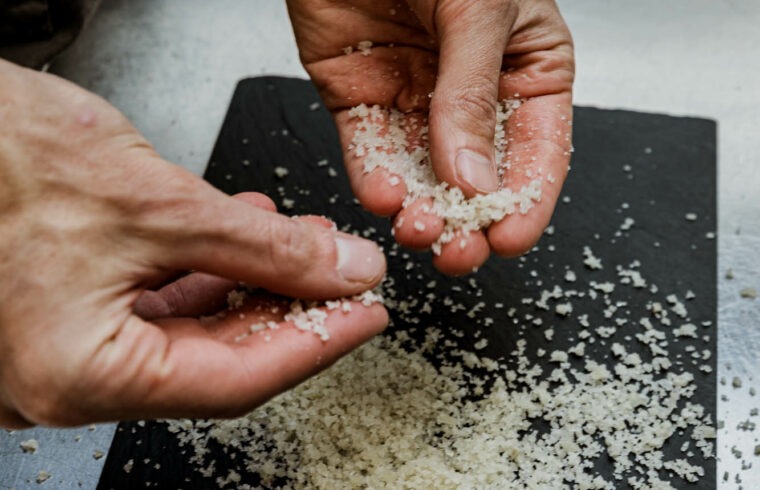The rise of AI & Critical Thinking
You might be tempted to rely more on AI-generated answers these days. However, it’s essential to critically evaluate the information presented to you, especially in an era where knowledge is instantly available, easily copied, and often lacks the nuance needed for accurate interpretation.
LLMs like ChatGPT (2025) may even provide different answers to similar questions about the effect of salt on sourdough fermentation. In some cases, they might claim that salt retards yeast growth more than lactic acid bacteria in sourdough fermentation. Really?

Figure: Growth rate of L. sanfranciscensis and Candida milleri (or Saccharomyces cerevisiae) as a function of increasing salt concentration (ionic strength). Blue text and lines added to original figure to provide additional context in line with information shared in this post.
The figure is taken from.
Ref. Michael G. Gänzle et al: Modeling of Growth of Lactobacillus sanfranciscensis and Candida milleri in Response to Process Parameters of Sourdough Fermentation, 29 April 1998
Take a look at the figure and the effect of salt (NaCl) on dominant lactic acid bacteria and yeast, commonly found in wheat and rye sourdough, subsequently L. sanfranciscensis and Candida milleri (or Saccharomyces cerevisiae) . Lets try to interpret the data in the figure and give it more context.
We know (or assume)
- In general bacteria grow faster than yeast.
- Different microbes display different reactions (strategies) to changing environmental conditions.
- Flour (ash) and water contain minerals (salts). Minerals affect protein structure and therefore their function. Enzyme (proteins) function depends on their structure. They play a key role in bread fermentation.
- Bread minerals originate from : (I) in flour flour (“ash”) (II) Water (soft or hard water), (III) added salt (common table or sea salt, NaCl, normally at 1.8 and 2.2 % amounts by flour weight)
- Many minerals are essentially naturally occurring salts.
Additional context.
Also good to know. if you read this post. The typical salt concentration in seawater is 3.5% of the water’s weight. Studies on the evolution of life suggest that the earliest life forms on Earth emerged around 4 billion years ago, likely originating in the ocean and sharing structural similarities with bacteria (compare: a loaf hydrated with 65% sea water is similar to 2,3 % added NaCl salt for that loaf using regular tap water).
Now Let’s try to interpret the data in the figure above
- Added NaCl has non linear stimulating and retarding effect on bacteria ( L. sanfranciscensis ), and a linear retarding effect on yeast (Candida milleri, or now classified as Saccharomyces cerevisiae)
- Assuming 2% NaCL in the figure corresponds to 1.3% by flour weight (for a 65% hydrated dough).
- Then adding up 1.3% salt (NacL) will speed up bacterial and mildly retard yeast growth (species under investigation). However above 1.3% (NaCl) bacterial growth is retarded (slowed down) very quickly, and only mildly reduces yeast growth.
- The article states that growth stops for the bacteria at NaCl 4% ( ∼ dough 2.6%) and 8% yeast (∼ dough 5.2%) /
- Note that other microbial species will display different salt tolerance!
Additional context and nuance
Why is L. sanfranciscensis often found as a dominant organism in sourdough?
Sanfranciscensis contains the smallest genome within the lactobacilli and the highest density of ribosomal RNA operons per Mbp genome among all known genomes of free-living bacteria, which is important for the rapid growth characteristics of the organism.
Ref. Genomic analysis reveals Lactobacillus sanfranciscensis as stable element in traditional sourdoughs
Sourdough contains more microorganisms.
L.plantarum is another common bacterium found in sourdough and is known to tolerate much higher salt concentrations than L. sanfranciscensis.
In conclusion
- Common – wheat and rye – sourdough salt concentrations vary between 1.8 to 2.2 % NaCl and are likely to retard bacterial ( L. sanfranciscensis) growth rate more than yeast
- At typical sourdough salt concentrations the growth rate of bacteria and yeast become similar and higher salt concentrations will favour yeast over bacterial growth rate.
- Salt concentrations can be ambiguous, as they may refer to either the weight of water or flour in a recipe. In bread recipes, salt percentages are typically calculated based on the weight of the flour.
- Sourdough can contain other bacterial species, such as L. plantarum, which may be significantly more salt-tolerant than L. sanfranciscensis.

